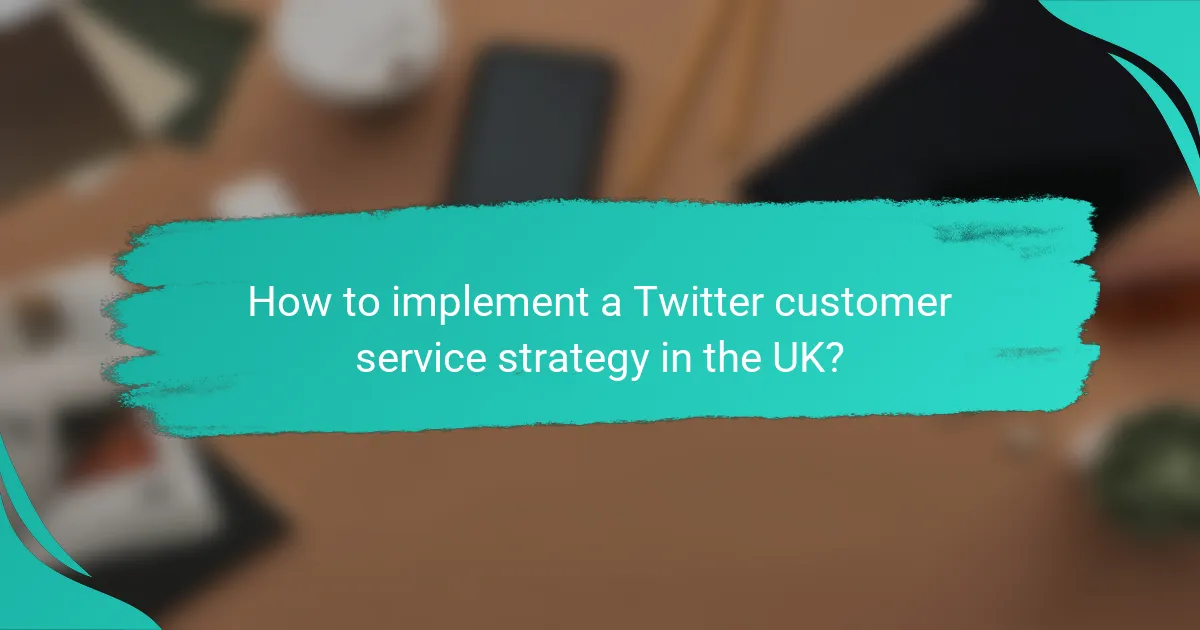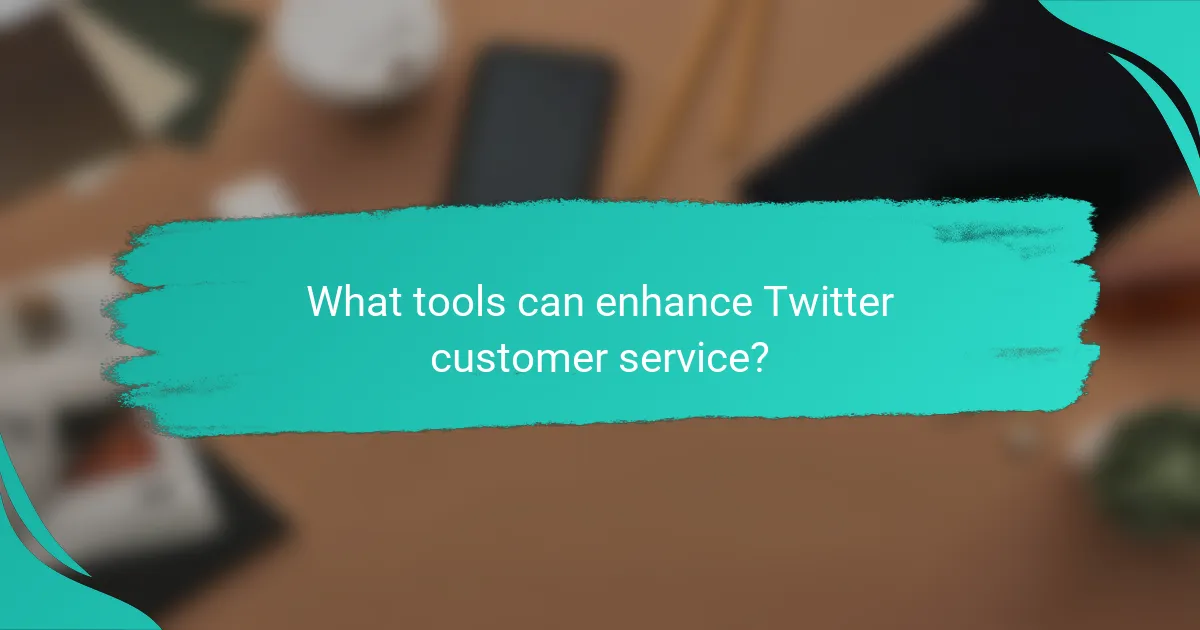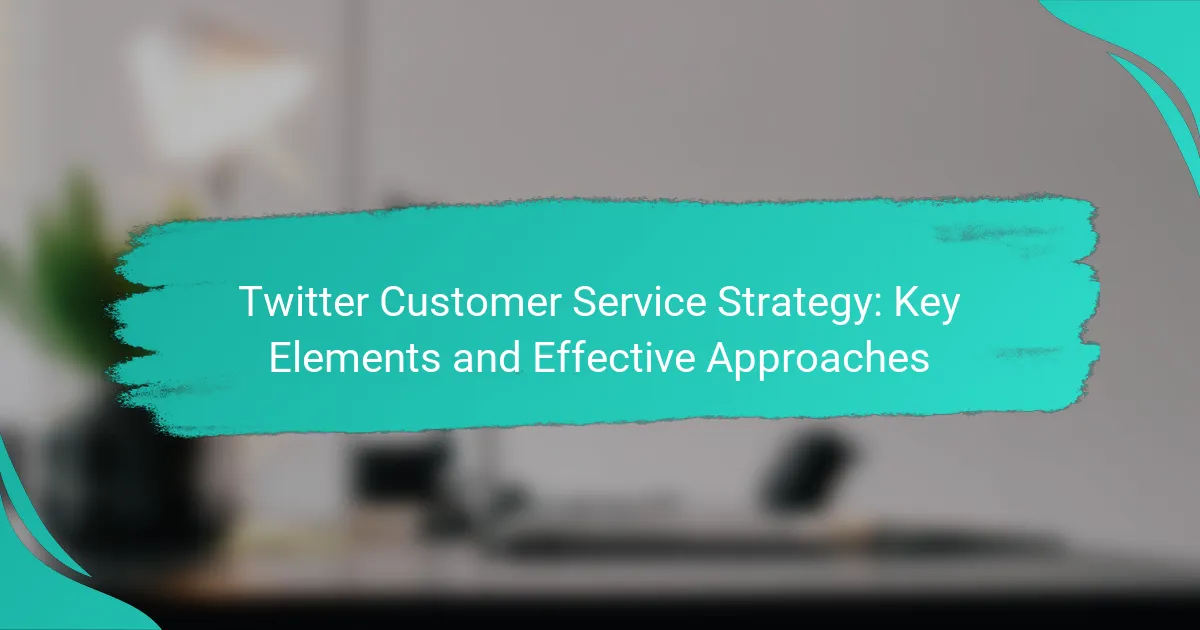Implementing an effective Twitter customer service strategy requires businesses to leverage the platform’s features for prompt engagement and active feedback monitoring. By focusing on clear communication, personalized interactions, and proactive issue resolution, companies can enhance customer satisfaction and foster brand loyalty. Measuring success through key performance indicators like response times and resolution rates further ensures that customer needs are met effectively.

How to implement a Twitter customer service strategy in the UK?
To implement an effective Twitter customer service strategy in the UK, businesses should focus on utilizing Twitter’s features, engaging with customers promptly, and monitoring feedback. This approach ensures that customer inquiries are addressed efficiently, enhancing overall satisfaction and brand loyalty.
Utilize Twitter’s customer service tools
Twitter offers several tools designed to enhance customer service, including direct messaging, Twitter Lists, and the ability to create a dedicated support account. Utilizing these features allows businesses to streamline communication and manage customer interactions more effectively.
Consider setting up a Twitter List for frequently asked questions or common issues, which can help your team respond quickly. Additionally, using Twitter’s analytics tools can provide insights into customer interactions and service performance.
Engage with customers in real-time
Real-time engagement is crucial for effective customer service on Twitter. Responding to customer inquiries and comments promptly can significantly improve customer satisfaction and demonstrate that your brand values their input.
Aim to respond to tweets within a few minutes to a couple of hours. This quick turnaround can help resolve issues before they escalate and shows customers that their concerns are taken seriously.
Monitor brand mentions and feedback
Regularly monitoring brand mentions and customer feedback on Twitter is essential for understanding public perception and addressing potential issues. Tools like TweetDeck or Hootsuite can help track mentions and keywords related to your brand.
Set up alerts for specific keywords or phrases to stay informed about customer sentiments. This proactive approach allows you to engage with customers who may not directly tag your account but are discussing your brand.
Establish response time benchmarks
Establishing clear response time benchmarks helps set expectations for both your team and your customers. Aim for a response time of under an hour for direct messages and within a few hours for public mentions.
Regularly review and adjust these benchmarks based on customer feedback and service performance. This practice ensures that your team remains accountable and continuously improves its response times.
Train staff on Twitter etiquette
Training staff on proper Twitter etiquette is vital for maintaining a professional and friendly brand image. Staff should understand how to communicate effectively, use appropriate language, and handle negative feedback gracefully.
Provide guidelines that include best practices for tone, response times, and how to escalate issues when necessary. Role-playing scenarios can also help staff prepare for various customer interactions they may encounter on the platform.

What are the key elements of a successful Twitter customer service strategy?
A successful Twitter customer service strategy hinges on clear communication, personalized interactions, proactive issue resolution, and maintaining a consistent brand voice. These elements work together to enhance customer satisfaction and foster loyalty.
Clear communication guidelines
Establishing clear communication guidelines is essential for effective customer service on Twitter. This includes defining response times, tone of voice, and the types of issues that can be addressed. For instance, aim to respond to inquiries within a few hours to demonstrate attentiveness.
Consider creating a style guide that outlines preferred language, emojis, and hashtags. This ensures that all team members convey consistent messages, which helps build trust with customers.
Personalized customer interactions
Personalization in customer interactions can significantly enhance the customer experience. Address customers by their names and reference their previous interactions to show that you value them as individuals. This approach can increase engagement and satisfaction.
Utilize customer data to tailor responses based on their history with your brand. For example, if a customer frequently asks about a specific product, provide updates or promotions related to that item to make your communication more relevant.
Proactive issue resolution
Proactive issue resolution involves anticipating potential problems and addressing them before they escalate. Monitor mentions of your brand and relevant keywords to identify issues early. This allows you to reach out to customers before they voice complaints publicly.
Implementing a system for tracking common issues can help your team respond more effectively. For example, if multiple customers report a similar problem, prepare a standard response or solution to streamline the process.
Consistent brand voice
Maintaining a consistent brand voice across all interactions on Twitter is crucial for building brand identity. Your tone should reflect your brand’s personality, whether it’s friendly, professional, or humorous. This consistency helps customers feel more connected to your brand.
Regularly review your tweets and responses to ensure they align with your established voice. Encourage team members to familiarize themselves with this voice to avoid mixed messages that could confuse customers.

How to measure the effectiveness of Twitter customer service?
To measure the effectiveness of Twitter customer service, focus on key performance indicators such as response times, resolution rates, and customer satisfaction. These metrics provide insights into how well the service meets customer needs and expectations.
Track response times and resolution rates
Response times refer to how quickly customer inquiries are acknowledged, while resolution rates indicate the percentage of issues successfully resolved. Aim for response times in the low tens of minutes and resolution rates above 80% for effective service. Regularly review these metrics to identify trends and areas for improvement.
Consider using tools that automatically log response times and resolutions for better accuracy. This data can help you adjust staffing or processes to enhance customer interactions.
Analyze customer satisfaction scores
Customer satisfaction scores, often gathered through surveys, reflect how customers feel about their service experience. Use simple rating systems, such as a scale from 1 to 5, to quantify feedback. Aim for scores above 4 to indicate a generally positive experience.
Regularly analyze this feedback to identify common pain points and areas for enhancement. Implementing changes based on customer input can significantly boost satisfaction levels.
Monitor engagement metrics
Engagement metrics, such as likes, retweets, and shares, provide insight into how customers interact with your responses. High engagement can indicate that your content resonates well with your audience. Aim to increase these metrics by creating informative and engaging responses.
Track engagement over time to assess the impact of your customer service strategies. Adjust your approach based on what types of responses generate the most interaction, ensuring that your service remains relevant and effective.

What tools can enhance Twitter customer service?
Several tools can significantly improve Twitter customer service by streamlining communication, tracking interactions, and analyzing performance. Utilizing the right platforms can help businesses respond efficiently and effectively to customer inquiries and feedback on Twitter.
Hootsuite for scheduling and monitoring
Hootsuite allows businesses to schedule tweets and monitor conversations in real-time, making it easier to manage customer interactions. By planning posts ahead of time, companies can maintain a consistent presence on Twitter while also responding promptly to customer queries.
Consider setting up streams to track mentions, direct messages, and keywords relevant to your brand. This proactive approach enables teams to engage with customers as issues arise, enhancing overall satisfaction.
Zendesk for ticketing integration
Zendesk integrates seamlessly with Twitter, converting tweets into support tickets for better tracking and management. This tool helps customer service teams prioritize and resolve issues more efficiently, ensuring no inquiry is overlooked.
Utilizing Zendesk can streamline workflows by allowing agents to respond to customers directly from the ticketing system. This reduces the time spent switching between platforms and helps maintain a clear record of interactions.
Sprout Social for analytics
Sprout Social provides in-depth analytics that can help businesses evaluate their Twitter customer service performance. By analyzing metrics such as response times and engagement rates, companies can identify areas for improvement and adjust their strategies accordingly.
Regularly reviewing these analytics can inform decisions on staffing, response strategies, and content types. This data-driven approach ensures that customer service efforts are aligned with business goals and customer expectations.

How to handle negative feedback on Twitter?
Handling negative feedback on Twitter requires a strategic approach that emphasizes promptness, professionalism, and empathy. Addressing concerns quickly can mitigate damage and demonstrate your commitment to customer satisfaction.
Respond promptly and professionally
Timeliness is crucial when responding to negative feedback on Twitter. Aim to reply within minutes to show that you value customer input and are actively engaged. A professional tone is essential; avoid defensive language and focus on constructive dialogue.
For instance, if a customer tweets about a delayed order, acknowledge their concern and provide an update on the situation. This not only addresses their issue but also reassures other customers observing the interaction.
Take conversations offline when necessary
Some issues may require more detailed discussions that are not suitable for public forums. If a conversation escalates or involves sensitive information, politely ask the customer to continue the discussion via direct messages or email.
For example, if a customer shares personal details about their complaint, respond with a message like, “We’d like to help you further. Please check your DMs for more information.” This approach protects customer privacy and allows for a more thorough resolution.
Show empathy and understanding
Demonstrating empathy is vital in addressing negative feedback. Acknowledge the customer’s feelings and validate their experience, which can help de-escalate the situation. Use phrases like “I understand how frustrating this must be” to convey that you are listening.
Additionally, consider offering a solution or compensation where appropriate. For example, if a customer is upset about a product defect, you might offer a replacement or a discount on their next purchase. This not only resolves the issue but can also turn a negative experience into a positive one.

What are the best practices for Twitter customer service?
Effective Twitter customer service hinges on prompt responses, clear communication, and a customer-centric approach. Implementing best practices can significantly enhance customer satisfaction and brand loyalty.
Timely Responses
Responding quickly to customer inquiries on Twitter is crucial. Aim to reply within minutes for urgent issues and within a few hours for less pressing concerns. Customers appreciate timely interactions, which can lead to higher satisfaction rates.
Utilize automated responses for common questions to ensure that users receive immediate acknowledgment. However, ensure that these automated replies are followed up with personalized responses as soon as possible.
Clear Communication
Clarity in communication is essential when addressing customer issues on Twitter. Use straightforward language and avoid jargon to ensure that your messages are easily understood. This helps in minimizing confusion and frustration for the customer.
When providing solutions, be specific about the steps the customer should take. For example, if a customer needs to reset their password, outline the exact steps in a concise manner.
Empathy and Personalization
Show empathy in your interactions by acknowledging the customer’s feelings and concerns. Personalizing responses can make customers feel valued and understood. Use their names and reference previous interactions when possible.
For instance, if a customer expresses frustration over a delayed order, respond with an understanding tone and provide updates on their order status. This approach can help in building a positive rapport.
Monitoring and Analysis
Regularly monitor your Twitter interactions to identify trends and common issues. Analyzing customer feedback can help you improve your service strategy over time. Use tools to track response times, customer satisfaction, and engagement levels.
Consider conducting periodic reviews of your customer service performance on Twitter. This can help in identifying areas for improvement and ensuring that your team is meeting customer expectations effectively.
Training and Development
Invest in training your customer service team on best practices for Twitter interactions. This includes understanding the platform’s nuances and developing skills in effective communication and conflict resolution.
Encourage ongoing learning by providing resources and workshops on social media customer service. This ensures that your team stays updated on the latest trends and techniques for effective engagement.
